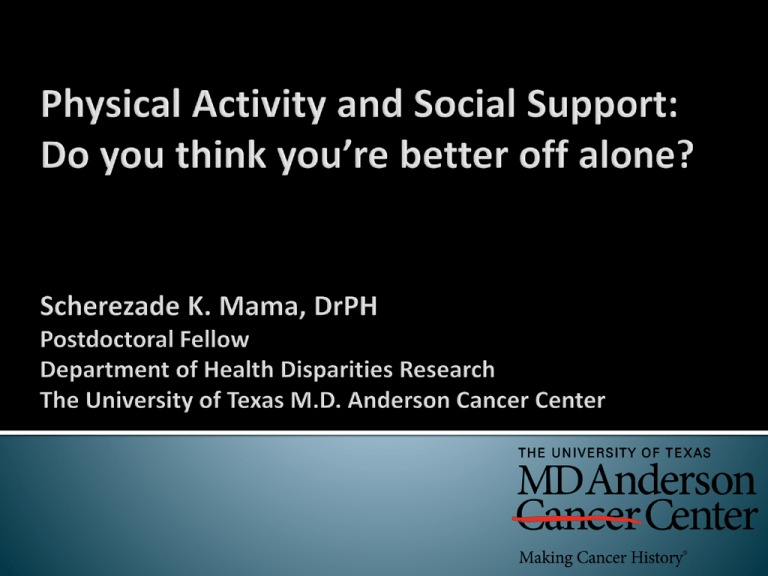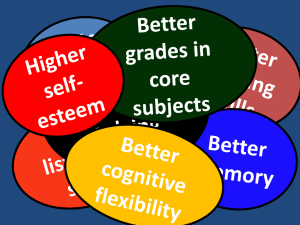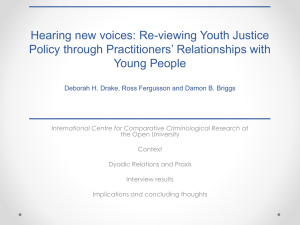
Percent Preventable
Physical activity
Obesity
100
90
80
70
60
50
40
30
20
10
0
World Cancer Research Fund/American Institute for Cancer Research. Policy and Action for Cancer Prevention. Food, Nutrition, and Physical Activity: a Global Perspective. Washington
DC: AICR; 2009.
60
Crude Percent
50
47.5
43.6
43.2
42.2
40
30
20
10
0
Ward BW, Schiller JS, Freeman G. Early release of selected estimates based on data from the January–September 2013 National Health Interview Survey. National Center for Health
Statistics. March 2014. Available from: http://www.cdc.gov/nchs/nhis.htm.
49.8
ADULTS 18 AND OVER BY SEX
60
60
54.7
50.3
40
30
10
10
Men
Women
42.7
Black
Hispanic/Latino
30
20
Total
41.7
40
20
0
53.9
50
46.2
Percent
Percent
50
ADULTS 18 AND OVER BY RACE/ETHNICITY
0
White
Ward BW, Schiller JS, Freeman G. Early release of selected estimates based on data from the January–September 2013 National Health Interview Survey. National Center for Health
Statistics. March 2014. Available from: http://www.cdc.gov/nchs/nhis.htm.
Public Policy
local, state and national laws and policies
Environmental Factors
access to recreational facilities, walkable communities, sidewalks
and bicycle lanes, worksite programs and policies, school-based programs
Interpersonal Relationships
social networks and support systems,
including family, friends, co-workers
Intrapersonal Factors
individual characteristics, such as age, sex, gender, beliefs,
motivation, self-concept, etc.
Physical Activity
Model adapted from: King AC, Sallis JF. Why and how to improve physical activity promotion: Lessons from behavioral science and related fields. Preventive Medicine. 2009; 49:28688.; McLeroy KR, Bibeau D, Steckler A, Glanz K. An ecological perspective on health promotion programs. Health Education & Behavior. 1988;15:351-77.
Intrapersonal Factors
•
•
•
Social Support
Cognition
Beliefs
Motivation
Physical Activity
Interpersonal relationships
Social support
Social networks
Social inequalities
Socioeconomic position and income inequality
Racial discrimination
Neighborhood and community characteristics
Social cohesion and social capital
Neighborhood factors
McNeill LH, Kreuter MW, Subramanian SV. Social environment and physical activity: A review of concepts and evidence. Social Science & Medicine. 2006;63:1011-22.
Social support
Resources provided by
other persons
Social networks
Collective structure of
social relationships that
surround an individual
Provide information on
how an individual is
integrated with others
McNeill LH, Kreuter MW, Subramanian SV. Social environment and physical activity: A review of concepts and evidence. Social Science & Medicine. 2006;63:1011-22.
Constrains the adoption
of health promoting
behaviors
Enables the adoption of health promoting
behaviors
Provides access to resources & material goods
Provides individual & community coping
responses
Buffers negative health outcomes
Restricts contact to infectious disease
McNeill LH, Kreuter MW, Subramanian SV. Social environment and physical activity: A review of concepts and evidence. Social Science & Medicine. 2006;63:1011-22.
Whitehall studies
(1984) showed health
gradients based on
occupational class
3 fold increase in
mortality between
lowest and highest
employment grades
Gradient persists after
controlling for smoking
Marmot MG, Shipley MJ, Rose G. Inequalities in death—specific explanation of a general pattern? Lancet. 1984;1(8384):1003-6.
Your place in the social
hierarchy
Indicators include
Individual income
Educational attainment
Occupational or job
status
McNeill LH, Kreuter MW, Subramanian SV. Social environment and physical activity: A review of concepts and evidence. Social Science & Medicine. 2006;63:1011-22.
↓ Accumulation of
and Access to
Material Resources
that Protect against
Stress
Socioeconomic
Position
↑ Biological Stress
McNeill LH, Kreuter MW, Subramanian SV. Social environment and physical activity: A review of concepts and evidence. Social Science & Medicine. 2006;63:1011-22.
↓ Health
Gilson D, Perot C. It’s the Inequality, Stupid. March/April 2011. http://www.motherjones.com/politics/2011/02/income-inequality-in-america-chart-graph.
Disinvestment in
Social Capital
Income Inequality
↓ Social Spending
on Programs and
Services
↑ Negative
Psychosocial
Conditions
McNeill LH, Kreuter MW, Subramanian SV. Social environment and physical activity: A review of concepts and evidence. Social Science & Medicine. 2006;63:1011-22.
↓ Social Cohesion
Differential treatment
Interpersonal
▪ Occurs between individuals
Institutionalized
▪ Discriminatory policies or practices
▪ Results in differential access to resources and societal
opportunities
▪ Restricted access to types of physical activity (e.g. baseball)
▪ Restricted access to physical activity venues (e.g. golf clubs,
swimming pools)
McNeill LH, Kreuter MW, Subramanian SV. Social environment and physical activity: A review of concepts and evidence. Social Science & Medicine. 2006;63:1011-22.
Emple H. Documenting Discrimination in Local Rental Markets. May 2013. http://assets.newamerica.net/blogposts/2013/documenting_discrimination_in_local_rental_markets83254.; Frey WH. America’s Diverse Future: Initial Glimpses at the U.S. Child Population from the 2010 Census. Washington, DC: Brookings; 2011.
http://www.brookings.edu/~/media/research/files/papers/2011/4/06%20census%20diversity%20frey/0406_census_diversity_frey.pdf.
↑ Economic and
Social Deprivation
Racial
Discrimination
↑ Exposure to
Harmful Substances
↑ Psychological
Trauma
McNeill LH, Kreuter MW, Subramanian SV. Social environment and physical activity: A review of concepts and evidence. Social Science & Medicine. 2006;63:1011-22.
PEOPLE
Individual factors that
influence health
PLACE
Characteristics of the place
where you live
Income and education
Social cohesion
Physical and mental health
Social capital
Knowledge, attitudes and
Neighborhood socioeconomic
beliefs about health-related
behaviors
Perceptions of interpersonal
bias or discrimination
position
Influence health-related
behaviors directly and
indirectly
McNeill LH, Kreuter MW, Subramanian SV. Social environment and physical activity: A review of concepts and evidence. Social Science & Medicine. 2006;63:1011-22.
Reinforces Group
and Social Norms
Social Cohesion and
Social Capital
↑ Health Behaviors
Provides Tangible
Support
McNeill LH, Kreuter MW, Subramanian SV. Social environment and physical activity: A review of concepts and evidence. Social Science & Medicine. 2006;63:1011-22.
Neighborhood
socioeconomic position
Deprivation
Home ownership
Presence/lack of
neighborhood resources
Supermarkets/grocery
stores
Parks, fitness and
community centers
Perception of crime
Low
% with no physical activity
No PA by Neighborhood
Deprivation and
Educational Attainment
Middle
High
25
20
15
10
5
0
Most affluent
McNeill LH, Kreuter MW, Subramanian SV. Social environment and physical activity: A review of concepts and evidence. Social Science & Medicine. 2006;63:1011-22.; Figure adapted
from Table 2 in Sundquist J, Malmstrom M, Johansson S. Cardiovascular risk factors and the neighbourhood environment: a multilevel analysis. Int J Epidemiol. 1999;28(5):841-5.
Most deprived
Smog, poor air quality
Elements of
the physical
environment
Neighborhood
Factors
Availability of
Support
Services
Social and cultural norms for
physical activity
Historical and
Cultural
Features
Lack of recreation facilities,
reduced PE in schools, limited
trash pick up
McNeill LH, Kreuter MW, Subramanian SV. Social environment and physical activity: A review of concepts and evidence. Social Science & Medicine. 2006;63:1011-22.
We know that
Physical inactivity is a problem.
The social environment plays an important role on
behavior.
BUT…Do the frameworks we have fit women?
…who are less physically active than men?
…have different social and cultural norms?
Vrazel J, Saunders RP, Wilcox S. An overview and proposed framework of social-environmental influences on the physical-activity behavior of women. Am J Health Promot.
2008;23(1):2-12.
Vrazel J, Saunders RP, Wilcox S. An overview and proposed framework of social-environmental influences on the physical-activity behavior of women. Am J Health Promot.
2008;23(1):2-12.
Most studied and understood construct
Consistently positively correlated with
physical activity among women
79.1% of studies addressed this
55.8% of these studies included ethnic
minorities
3 major types
Emotional
Tangible
Informational
Vrazel J, Saunders RP, Wilcox S. An overview and proposed framework of social-environmental influences on the physical-activity behavior of women. Am J Health Promot.
2008;23(1):2-12.
Ethnic minority women with low physical
activity support are more likely to be
sedentary
Women with high support were more likely to
Meet leisure-time physical activity
recommendations (≥150 min/week)
Lead a physically active lifestyle (~300 min/week)
Support from family and friends predicts
exercise adherence
Eyler AA, Brownson RC, Donatelle RJ, King AC, Brown D, Sallis JF. Physical activity social support and middle- and older-aged minority women: results from a US survey. Soc Sci Med.
1999;46(6):781-9.; Oka R, King AC, Young D. Sources of social support as predictors of exercise adherence in women and men ages 50 to 65 years. Womens Health. 1995;1(2):161-75.
Print+Community
Development
Intervention
Women with
increased partner
support were 2.29
times more likely to
meet PA guidelines
Miller YD, Trost SG, Brown WJ. Mediators of physical activity behavior change among women with young children. Am J Prev Med. 2002;23(2 Suppl 1):98-103.
Must be tailored and
include
Benefits of physical activity
for women
Strategies to incorporate
into women’s lives
Increases exercise
adherence
More valuable from
health professionals
Duncan T, Duncan S, McAuley E. The role of domain and gender specific provisions of social relations in adherence to a prescribed exercise regimen. J Sport Exerc Psychol.
1993;15:220-31.
LIFE TRANSITIONS
Marriage
Parenthood
Employment
MULTIPLE ROLES
Wife
Mother
Employee
Caretaker
Head of household
53.5% of studies addressed this
60.9% of these studies included ethnic minority women
Vrazel J, Saunders RP, Wilcox S. An overview and proposed framework of social-environmental influences on the physical-activity behavior of women. Am J Health Promot.
2008;23(1):2-12.
Women were more likely to be “inactive” if
they reported
Getting married (OR=1.46)
Giving birth to a first (OR=2.27) or subsequent
child (OR=2.06)
Becoming a single parent (OR=1.32)
Beginning work (OR=1.15)
Brown WJ, Trost SG. Life transitions and changing physical activity patterns in young women. Am J Prev Med. 2003;25(2):140-3.
Related to increasing
responsibilities
Lack of time is #1 barrier
Family responsibilities are a
priority
▪ Require a lot of time
▪ Physically demanding
Household and caregiving
responsibilities limit
leisure-time/physical
activity
“I think aerobics, like [doing
an] aerobics tape is a waste
of time. You stand there
doin‘ that, you're not
accomplishing anything. If
you were dusting, and
carpet sweeping the floor,
or vacuuming, you're doing
something.”
Vrazel J, Saunders RP, Wilcox S. An overview and proposed framework of social-environmental influences on the physical-activity behavior of women. Am J Health Promot.
2008;23(1):2-12.; Eyler AA, Baker E, Cromer L, King AC, Brownson RC, Donatelle RJ. Physical activity and minority women: a qualitative study. Health Educ Behav. 1998;25(5):640-52.
12
Social roles
and
responsibilities
10.43
Active Living
Household/Caregiving
10
Occupational
Odds Ratio
Busy schedules
Sports/Exercise
8
5.66
6
4
3.05
2.13
2.79
2
Physical
activity
0
1.29
Married
1 Child
1.27
2+ Children
Employed High Support
Vrazel J, Saunders RP, Wilcox S. An overview and proposed framework of social-environmental influences on the physical-activity behavior of women. Am J Health Promot.
2008;23(1):2-12.; Sternfeld B, Ainsworth BE, Quesenbury CP. Physical activity patterns in a diverse population of women. Prev Med. 1999;28(3):313-23.
Women think they are doing enough physical
activity because they are busy.
May not be enough to benefit their health,
but not willing to add more to their schedule.
Social roles and
responsibilities
Busy schedules
Physical activity
Vrazel J, Saunders RP, Wilcox S. An overview and proposed framework of social-environmental influences on the physical-activity behavior of women. Am J Health Promot.
2008;23(1):2-12.
Too tired to
exercise
Most complex aspects of the social
environment
Least understood and studies
39.5% of studies looked at this
76.5% of these studies included ethnic minorities
Key issues
Acceptance of physical activity
Cultural appropriateness of physical activity for
adult women
Lack of role models
Vrazel J, Saunders RP, Wilcox S. An overview and proposed framework of social-environmental influences on the physical-activity behavior of women. Am J Health Promot.
2008;23(1):2-12.
Need spouse to give
consent or allow them
time to do physical
activity
“Unless it fits into the
usual family life pattern,
PA does not happen.”
Especially true among
“I think that’s probably
the biggest obstacle is
getting out of the house.
To even do it. And the
support is where it comes
in.”
Hispanics
Lack of acceptance
leads to feeling guilty
or selfish
Vrazel J, Saunders RP, Wilcox S. An overview and proposed framework of social-environmental influences on the physical-activity behavior of women. Am J Health Promot.
2008;23(1):2-12.; Berg J, Cromwell S, Arnett M. Physical activity: perspectives of Mexican American and Ango American midlife women. Health Care Women Int. 2002;23(8):894-904.
Gender-role expectations
Social and cultural
pressure to
Conform to role as mothers
Conform to role as primary
caretakers/caregivers
Put family obligations and
relationships ahead of their
own needs
Vrazel J, Saunders RP, Wilcox S. An overview and proposed framework of social-environmental influences on the physical-activity behavior of women. Am J Health Promot.
2008;23(1):2-12.
Lack of role models
adds to perceived lack
of community and
social support
Role models would
Make physical activity
more socially acceptable
Make women feel
comfortable and
confident about being
physically active
Vrazel J, Saunders RP, Wilcox S. An overview and proposed framework of social-environmental influences on the physical-activity behavior of women. Am J Health Promot.
2008;23(1):2-12.
Vrazel J, Saunders RP, Wilcox S. An overview and proposed framework of social-environmental influences on the physical-activity behavior of women. Am J Health Promot.
2008;23(1):2-12.
Potential Targets
Intervention Strategies
Individual women
Educational programs emphasizing
importance of PA for women*
Programs to develop communication and
support-seeking skills
Programs with culturally appropriate
options and instructions for exercise
Key individuals (e.g. spouse, partner,
family member)
Programs teaching family members skills
for providing support (e.g. sharing duties)
Programs involving key individuals in PA
Health care providers
Programs to develop emotional and
informational support skills
Educational materials to give to women
*Applicable to all potential targets
Vrazel J, Saunders RP, Wilcox S. An overview and proposed framework of social-environmental influences on the physical-activity behavior of women. Am J Health Promot.
2008;23(1):2-12.
Potential Targets
Intervention Strategies
Leaders in workplace, clubs, churches, or other
social settings
Programs targeting key leaders to enhance
acceptance of PA for women
Recognition of leaders who support PA through
advocacy, policies and modeling
Organization or group
Programs to strengthen existing support
networks for PA
Programs to develop new networks for PA
Creation of worksite policies that enhance PA
(e.g. childcare, flexible schedule)
Organization provides additional PA
opportunities and support services
Community-wide
Provide childcare support services
Provide programs allowing women to trade
time with other mothers for PA time
Create or recognize active role models
Vrazel J, Saunders RP, Wilcox S. An overview and proposed framework of social-environmental influences on the physical-activity behavior of women. Am J Health Promot.
2008;23(1):2-12.
Potential Targets
Intervention Strategies
Community campaigns targeting key
Media and social marketing interventions
individuals, key leaders and organizations, to
and health care providers
• Change norms for PA in women
• Increase acceptance of PA
• Provide positive, active role models
• Develop health communication
messages that emphasize the
importance of PA to women’s health
Advocacy and public policy campaigns
Organize and support efforts to create
acceptable and appropriate opportunities
for women to be physically active (e.g.
women-friendly facilities)
Vrazel J, Saunders RP, Wilcox S. An overview and proposed framework of social-environmental influences on the physical-activity behavior of women. Am J Health Promot.
2008;23(1):2-12.
Cavallo DN, Brown JD, Tate DF, DeVellis RF, Zimmer C, Ammerman AS. The role of companionship, esteem, and informational support in explaining physical activity among young
women in an online social network intervention. J Behav Med. 2013; In press. DOI 10.1007/s10865-013-9534-5
COMPLETERS
Leisure-time
Occupational
12
Total
Physical activity (hours/week)
Physical activity (hours/week)
Total
NONCOMPLETERS
10
8
6
4
2
0
Leisure-time
Occupational
14
12
10
8
6
4
2
0
Baseline
1-year follow-up
Baseline
1-year follow-up
Huberty JL, Ehlers D, Coleman J, Gao Y, Elavsky S. Women Bound to be Active: Differences in long-term physical activity between completers and noncompleters of a book club
intervention. J Phys Act Health. 2013;10(3)368-78.
“The interaction with women [in WBA] was very
rewarding.”
“They [WBA women] were great as an initial ‘get
going,’ but then I kinda went on my own and
family became more of my support.”
“I learned this skill…of reaching out and asking
for support or looking for support…that has
stayed with me since the program.”
Huberty JL, Ehlers D, Coleman J, Gao Y, Elavsky S. Women Bound to be Active: Differences in long-term physical activity between completers and noncompleters of a book club
intervention. J Phys Act Health. 2013;10(3)368-78.
SisterTalk
12 one-hour weekly programs
Mailed corresponding print material
Goals to “eat better, move more and feel great”
Risica PM, Gans KM, Kumanyika S, Kirtania U, Lasater TM. SisterTalk: final results of a culturally tailored cable television delivered weight control program for Black women. Int J Behav
Nutr Phys Act. 2013;10:141.
80
Δ1.47
Total Leisure Activity Score
75
Δ0.49
Δ4.62
70
65
Intervention
60
Δ-2.75
55
Δ-0.40
Control
Δ-1.07
50
45
40
Baseline
3-months
8-months
12-months
Risica PM, Gans KM, Kumanyika S, Kirtania U, Lasater TM. SisterTalk: final results of a culturally tailored cable television delivered weight control program for Black women. Int J Behav
Nutr Phys Act. 2013;10:141.
Microsystem
Macrosystem
Mesosystem
Vrazel J, Saunders RP, Wilcox S. An overview and proposed framework of social-environmental influences on the physical-activity behavior of women. Am J Health Promot.
2008;23(1):2-12.
Scherezade K. Mama, DrPH
Postdoctoral Fellow
Department of Health Disparities Research
The University of Texas M.D. Anderson Cancer Center
Houston, Texas
Email: skmama@mdanderson.org
Phone: 713-563-7546







![presentation [MS PowerPoint 189KB]](http://s2.studylib.net/store/data/005263596_1-69d08c3f7e80bd1aee48ef31e66ebbc5-300x300.png)

